Neural Replay, Sleep, Memory Consolidation
1/35
There's no tags or description
Looks like no tags are added yet.
Name | Mastery | Learn | Test | Matching | Spaced |
|---|
No study sessions yet.
36 Terms
What did Jenkins & Dallenbach (1924) do and find?
Investigated the role of sleep in memory by asking 2 participants to learn lists of 10 nonsense syllables until they reached mastery then tested recall after varying time intervals (1, 2, 4, 8 hours) filled with either sleep or wake
Found that regardless of the delay period, performance was better when there was sleep between learning and recall suggesting that sleep can protect against forgetting
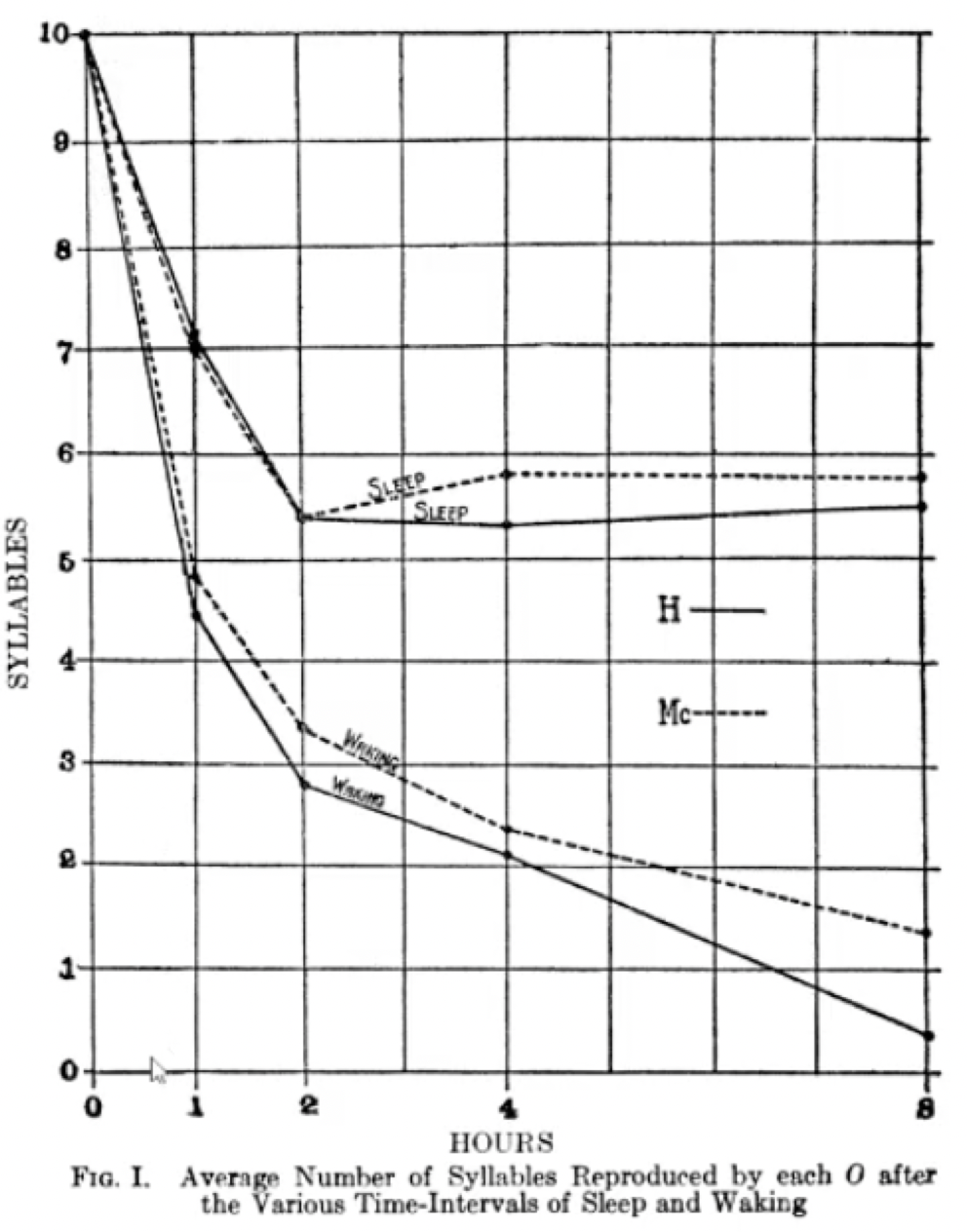
What are the two perspectives of the protective nature of sleep on memory?
It is a passive mechanism
we obtain less information and stimulation during sleep which reduces interference between the learnt words and other information
It is an active mechanism
the brain states when we sleep promote stabilisation and transfer across brain regions
What are the characteristics of sleep?
Sleep is not a homogenous state and cycles over 90 minutes from light to deep sleep and back again
What are the two main types of sleep?
REM and NREM stages
REM = eyes move about in a non-parallel fashion, dreams often occur in this stage, very close to being conscious
NREM = 4 stages that differ in how deep they are with NREM-4 being the deepest

When does each type of sleep occur?
Throughout the night individuals cycle through 5 stages of sleep, however, the proportion of REM sleep increases towards the end of the night while there is more deep sleep in the first half
Evidence has suggested that the differences in proportion of REM and NREM sleep could link to the consolidation of different types of memory, deep sleep and declarative memory and REM sleep and non-declarative memory
What did Plihal & Born (1997) do?
Tested the differential effect of sleep composition on declarative and procedural memory
first group learnt skills at 10/11 pm and then were woken for testing at 2/3 am
second group slept, were woken at 2/3 am for learning then were tested in the early morning
also wake groups who learnt and recalled earlier or later
The declarative memory task was a paired-associate task
The procedural task was a mirror tracing task
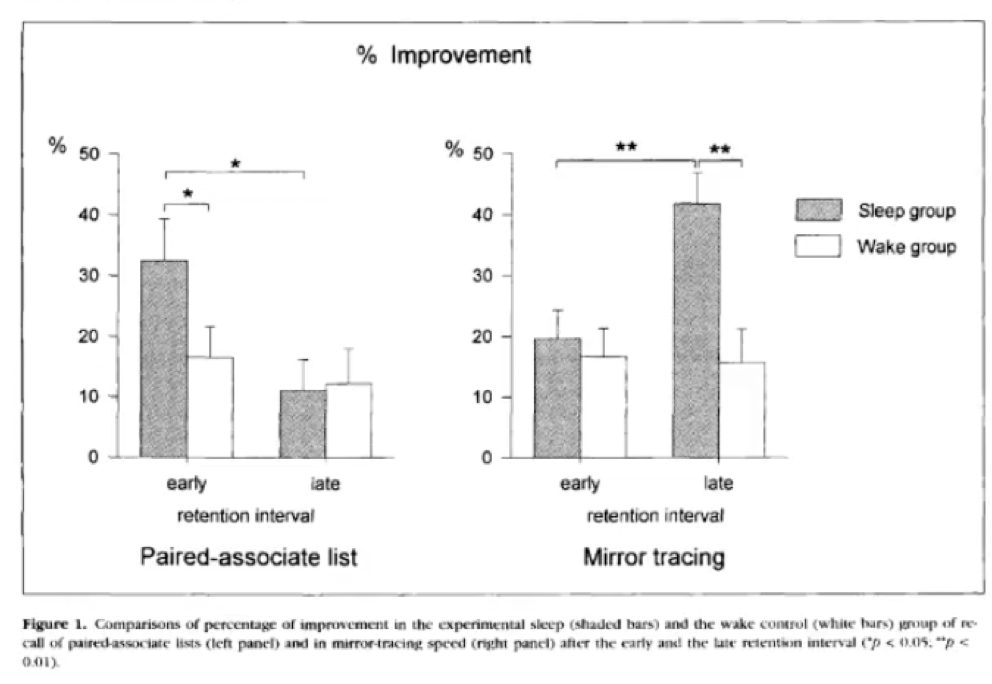
What did Plihal & Born (1997) find?
For both tasks, found an interaction between task type and time of night for both memory types in the sleep groups
Performance on the paired-associate task was enhanced when learning and recall took place earlier compared to later when Ps slept in between and compared to learning earlier with wake in between. There was no difference in performance between sleep and wake groups when learning and recall took place later on.
Performance in the mirror tracing task was significantly better in the group who learnt and recalled the skill later compared to those who learnt and recalled the skill earlier and those who experienced wake in between learning and recall. There was no difference between sleep and wake groups when learning and recall took place earlier in the night
These results indicate that differences in sleep composition through the night can influence retention of different memories and suggests that declarative memories are promoted by slow wave sleep while motor skills are improved by REM sleep
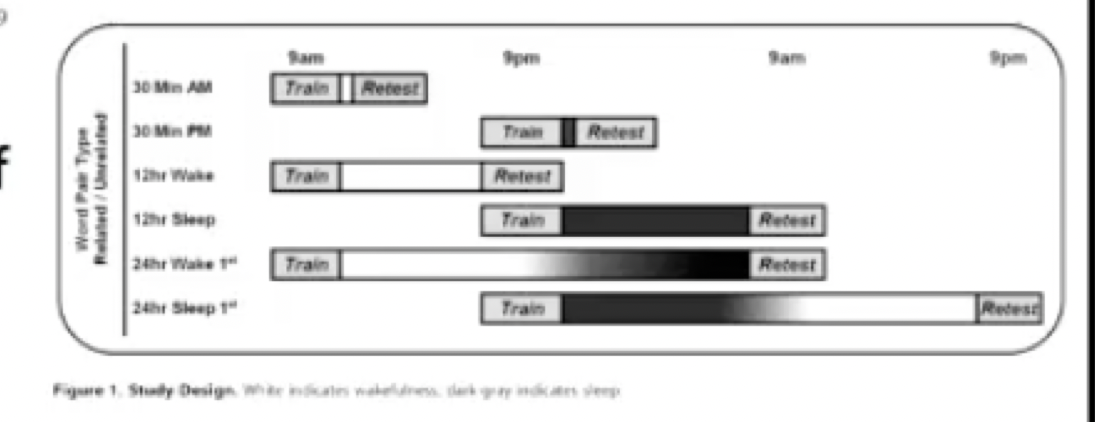
What did Payne et al. (2012) do?
Trained participants on unrelated or related pairs of items either in the morning, meaning they had 12 hours of wake following training, these individuals were either retested immediately or after 12 hours or after 24 hours (wake then sleep = delayed sleep). Other group of Ps were trained on these words in the evening then asked to go to sleep, retested either immediately, after 12 hours of sleep or after 24 hours (sleep then wake delayed wake)
Learning of pairs (unrelated in white) occurred until Ps obtained 24/40
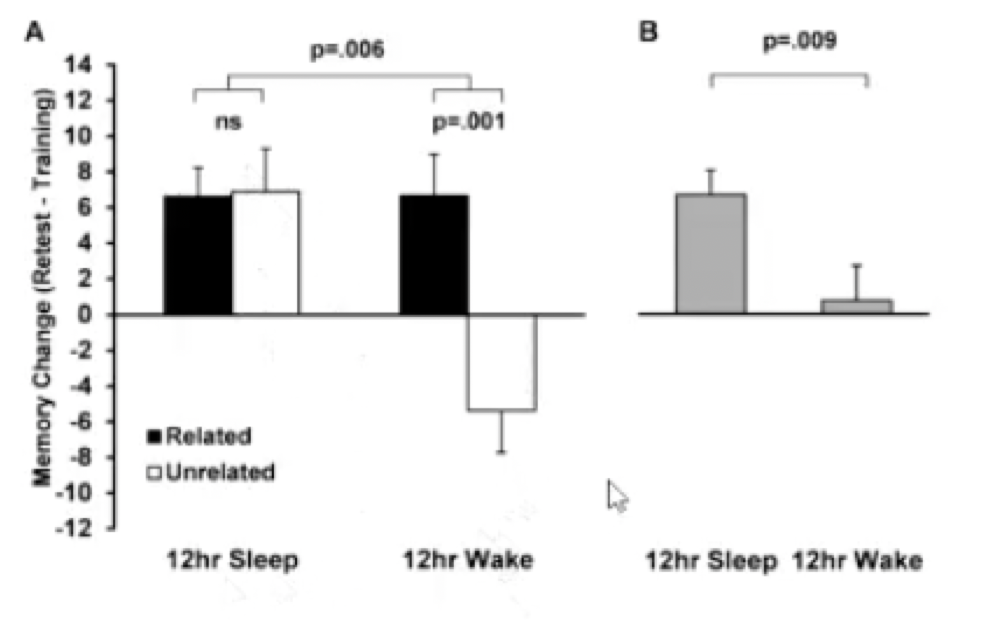
What did Payne et al. (2012) find for Ps who were retested 12 hours after learning (sleep or wake)?
Overall there was better performance in the sleep group than the wake group. However when investigating performance on unrelated and related word-pairs, Ps in the sleep group performed significantly better on unrelated word-pairs than the wake group.
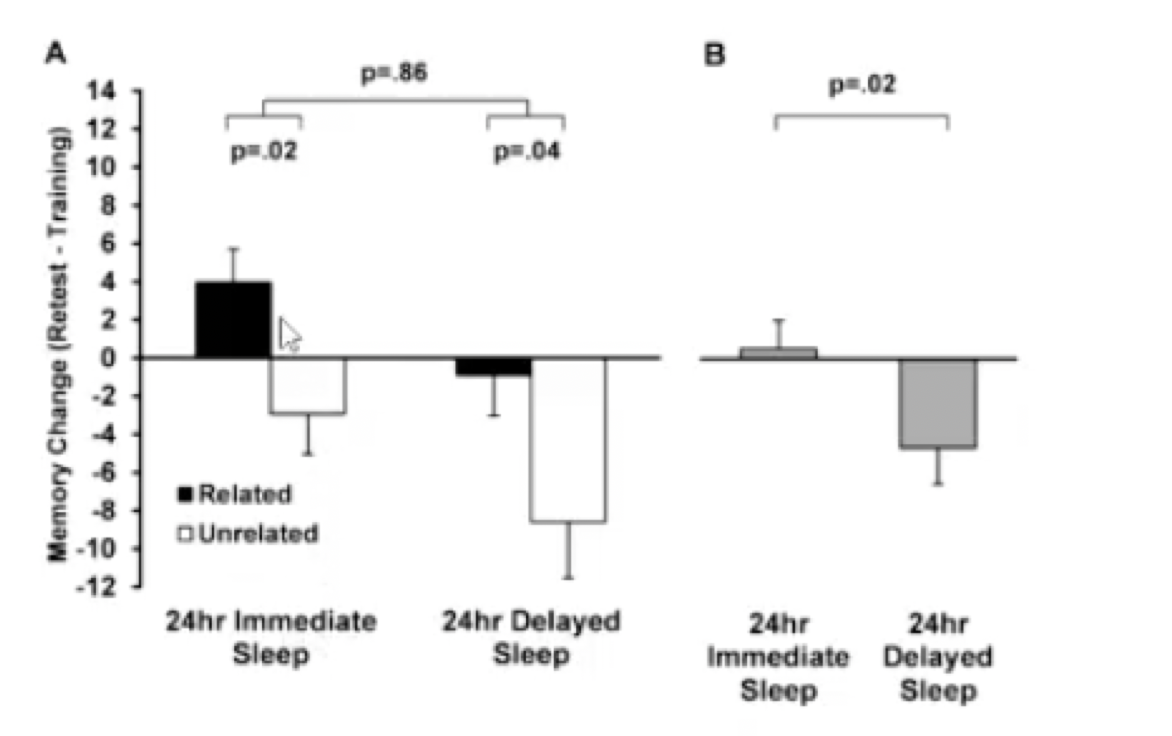
What did Payne et al. (2012) find in Ps who were retested 24 hours after learning (immediate or delayed sleep)?
After 24 hours there was better recall for those who slept immediately after training and they experienced little decay. Those who experienced delayed sleep showed large reduction in performance
There was a temporal gradient of retroactive facilitation
These results indicated that the absence of interference as well as system consolidation during slow-wave sleep could be behind this effect
What is neural replay?
Within a 24hr period there are times where the brain spontaneously replays to itself the information it recently acquired and this often occurs unconsciously, it permits other brain areas to learn this information
Slow-wave sleep seems to be an important time for neural replay, this is because
individuals are hard to wake
hippocampus becomes less plastic and you can’t learn new things at this time
hippocampus and neocortex communicate
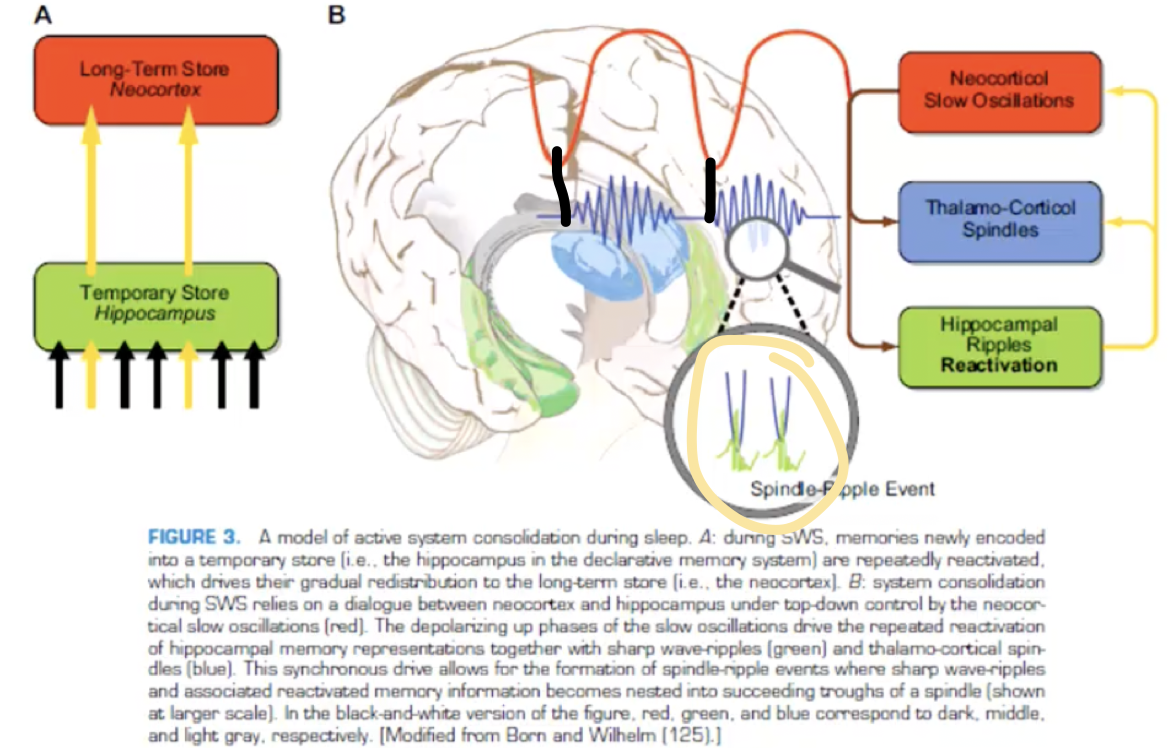
How does neural replay occur during slow-wave sleep (Born et al.)?
Propose there are 3 layers from the outer layer of the brain to the hippocampus, during SWS
In the neocortex
Brain activity of the neocortex are very slow, waves/oscillations are ample and this activity triggers activity in the middle layer, the thalamus
In the thalamus
spindles, which are shorter events of a higher frequency, are triggered
the beginning of a slow oscillation in the neocortex are likely to coincide with the beginning of a spindle in the thalamus
In the hippocampus
ripple events occur which are very jittery, noisy and nonharmonious movements and are very short
these align with the trough of the spindles to cause a spindle-ripple event
Alignment of electrical activity across layers promotes the movement of information from the temporary store in the hippocampus to the long-term store in the neocortex

What did Rash et al. (2007) do (perfume & neural replay)?
Asked participants to complete a spatial memory task where they had to remember pairs and card locations. For some individuals, researchers infused an odour into the room. This is because memory should contain contextual information during encoding including odour. Then when some Ps were asleep and entering SWS, the odour was infused into the room
If neural replay is occurring at this stage this odour should guide what is being replayed (cued reactivation) and enhance memory/task performance
There were many conditions e.g., no odour, same odour at learning and SWS, different odours, odour during SWS only, odour during learning and waking
What did Rash et al. (2007) find?
Only when the same odour is presented during learning and SWS influenced recall the next day. Re-exposure to the associated odour during SWS reactivated hippocampal areas active during learning. As Ps slept in scanner, researchers found that hippocampus activity was greater when an odour was presented in SWS when that odour was presented during learning (not with a different odour) and this resulted in enhanced performance the next day.
Provides evidence that neural replay can be actively manipulated
What else has reactivation be replicated with?
Cues such as music and words have also been used to reinvoke target memories during slow-wave sleep
What did Dumay (2018) aim to study (sleep and memory accessibility)?
Whether neural replay was a free, active learning mechanism rather than a mechanism that just prevents forgetting
To do this, needed to investigate the loss and gain of individual words
What does difference to equilibrium show?
In these charts the 0 point on the axis shows when an individual does not maintain more items than they have forgotten based on initial recall and forgetting
For example, if from a list of 20 items an individual recalls 10, 10 is the maximum number that can be maintained so if 5 are recalled at retest then 5 have been lost
50/50 situation is the midpoint or the zero and is calculated by initial individual recall and a score of 0 indicates the individual has not recalled or lost more words
The same logic applies for the gained items, if out of 20 items an individual can’t recall 6, 6 is the maximum number that could be gained and so a gain of 3 items would be average
What is reminiscence?
Recall of a previously lost item or memory, the ability to access knowledge that was accessible prior
What did Dumay (2018) do?
Asked Ps to engage either in a free recall or recognition task, obtained one dataset and asked colleagues for the other datasets
Tracked recall of each word at each time point for each participants and asked wither the word is recalled at test, re-test, one only or neither and words could be remembered initially then forgotten or forgotten initially then recalled later (reminiscence)
A smaller decline in performance when sleep is in the interval does not mean that sleep just prevents forgetting, so separated maintained and gained items at test and retest
Some participants slept between immediate recall and retest, some did not
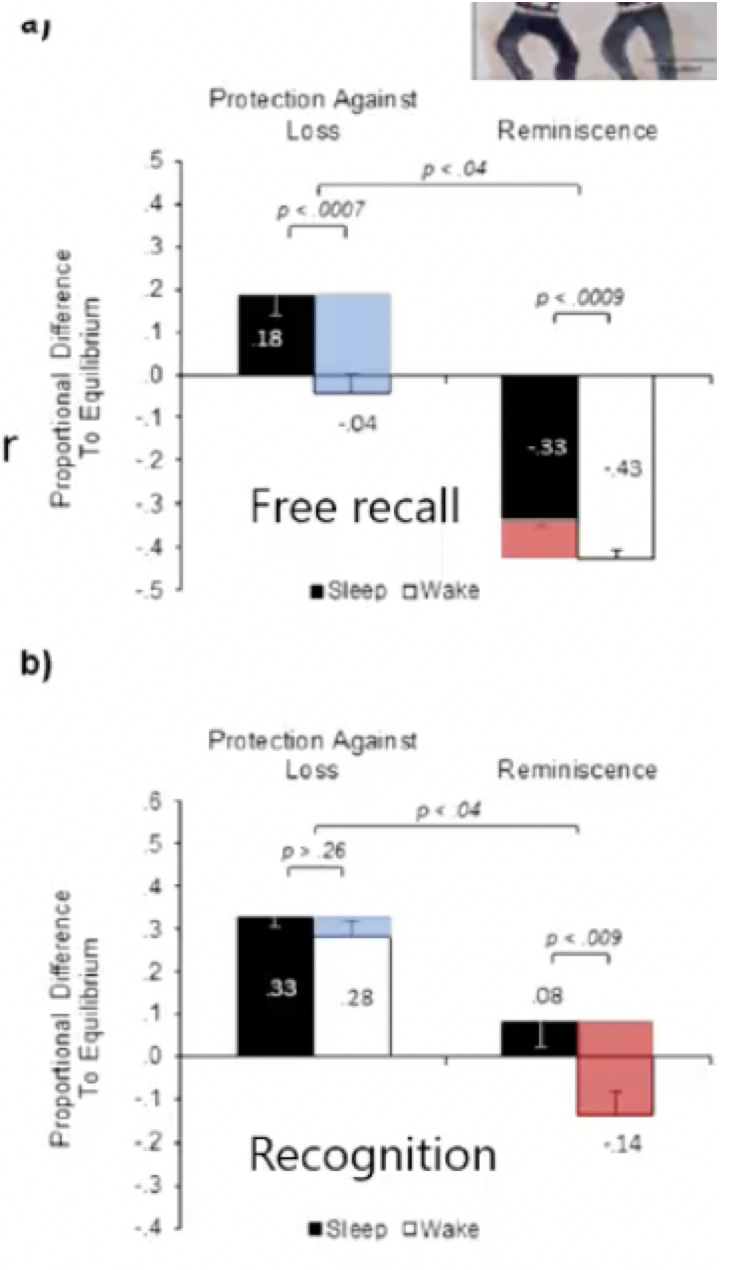
What did Dumay (2018) find?
Overall, the probability of maintaining items is greater than reminiscing items
For free recall
reminiscing is a rare event compared to maintenance
but for both, those who slept in the interval maintained and gained more than those who stayed awake
For recognition there was a similar pattern
sleep in the interval did not affect maintenance
however, sleep in the interval significantly increased probability of gaining than wake in the interval
What did Dumay’s (2018) results indicate?
Sleep increased the probability of gaining access to previously inaccessible knowledge in both recall and recognition tasks and prevented forgetting to a better degree compared to wake in the recall task
Sleep does not just stabilise memories to prevent forgetting, it can make previously inaccessible memories, accessible
What did Payne et al. (2009) do (sleep and gist extraction)?
Utilised the Deese-Roediger-McDermott paradigm to investigate how sleep impacts memory formation and distortion
Ps had to learn 8 lists of 12 semantically related words that were strongly associated with a critical missing word
for example, door, glass, pane but the critical target window was missing
Asked whether sleep could predict the likelihood of accidentally recalling the missing target words
Investigated groups who either were awake between testing, who slept properly between testing or napped for 60-90 mins between testing
What did Payne et al. (2009) find?
Overall found better recall following sleep compared to wake. Found that while there was no difference between sleep and wake on random intrusions, there was greater intrusion of the critical word after sleep compared to wake
When investigating the role of naps on recall found no difference in overall recall in those who napped and those who stayed awake. However, napping did increase intrusions of these critical words.
Overnight sleep and napping increased the number of false memories (not mere intrusions) suggesting that the gist of information is extracted during sleep and sleep strengthens associations between individual memory elements and fills in the gaps
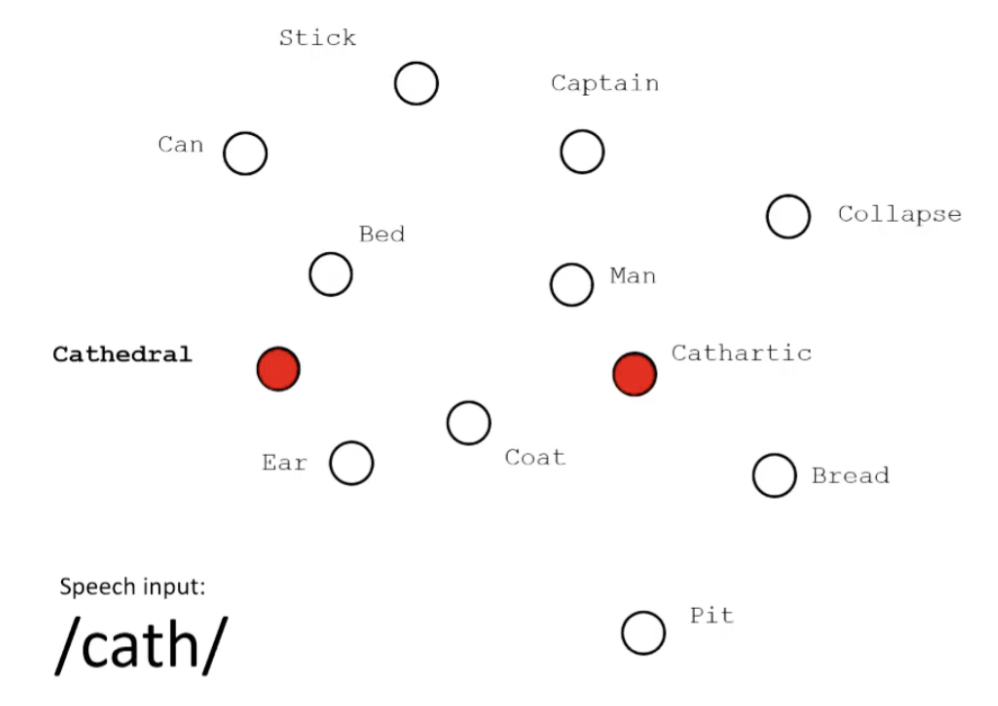
How does the lexicon work in response to input?
With each phoneme, the internal lexicon slowly narrows down the possible answers to the current input, this continues until there is one possible word from the input
For example for cathedral, this extraction and recognition of the word can occur by the fourth phoneme, gives /cathe/
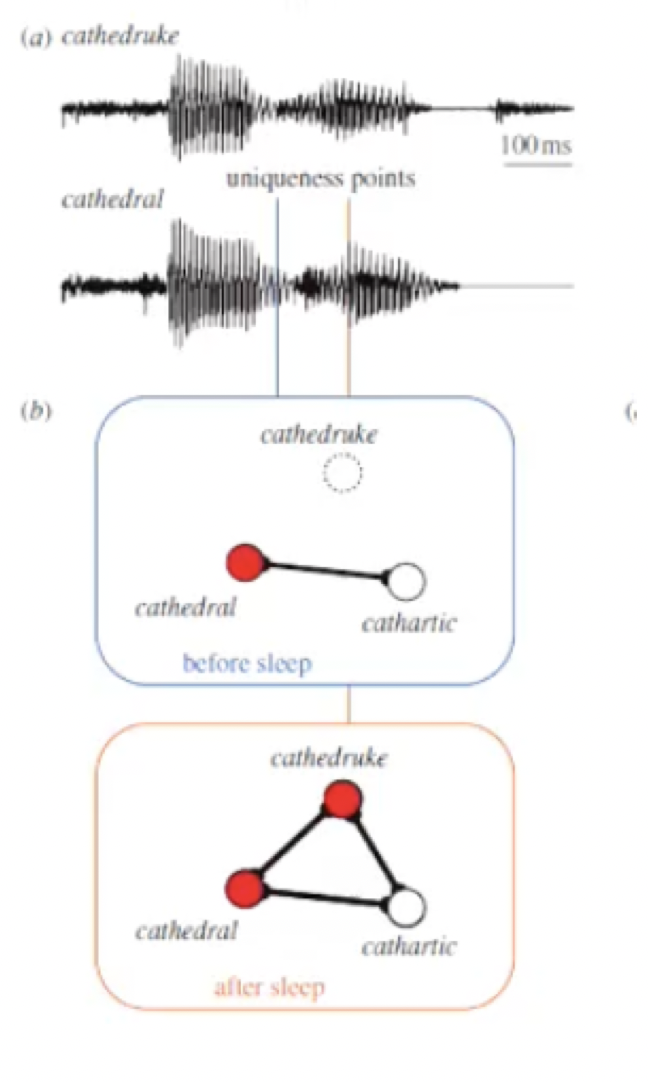
What did Dumay & Gaskell (2007) do (new info and sleep)?
Used the mechanism of the lexicon, and taught Ps new words that were similar to existing English words at the beginning of the word to create stronger contention and cause Ps to wait longer to be sure of the word
This training phase lasted an hour and included words such as cathedruke for cathedral which means Ps must hear /cathedra/ before they are sure of the word
Some Ps were trained in the morning, then experienced 12 hours of wake while the others were trained in the evening and experienced 12 hours of sleep
At retest Ps were asked to listen to the English words and had to recognised whether the sound of the video file was faulty (50% were, was a brief silence), if the fake word was learnt it should take longer for Ps to differentiate between faulty and intact files
What did Dumay & Gaskell (2007) predict?
If neural replay is a model that is useful, and information is stored initially in the hippocampus and semantic and visual word form in the neocortex
if neural replay connects old and new information, learning of the novel word at first will not be in contact with familiar words as there is no bridge between knowledges
only once this knowledge has been slept on has new connected to old knowledge and they are stored in the same region
The point where the word becomes unique should differ before and after an individual sleeps (native language not affected prior to sleep)

What did Dumay & Gaskell (2007) find?
Researchers measured reaction times between each condition (AM/PM) before and after sleep as an index for the lexical competition effect
Only half of the words were trained with competitors so bars showed the differences (subtraction) between performance in trained and baseline words
At immediate testing, there is no significant difference between groups for the effect of the competitor word on reaction times
At the 12 hr retest (one group has slept)
Competitive words have begun to cause interference during testing when individuals had slept in the interval
At the 24 hr retest - both groups have now slept
both groups showed the same level of interference (result of both having slept), reaction time is greater
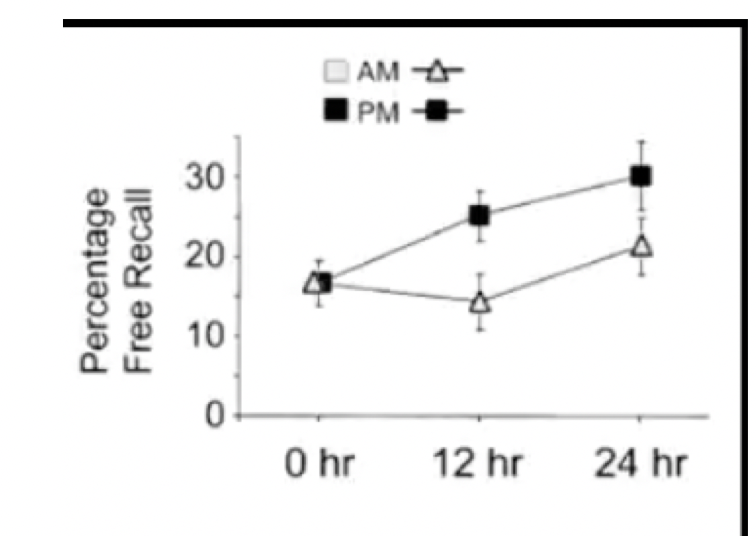
What did Dumay & Gaskell’s findings suggest?
Assimilation of novel words in lexical memory appears to occur while we sleep as part of consolidation (Wang et al., 2017, a replication)
Free recall shows enhanced memory performance after sleep but not after wake

What did Wagner et al. (2001) do?
Wanted to investigate the role of emotion in memory consolidation so asked Ps to learn two narratives one that was neutral and about making clay sculptures another that was emotive and about child murder
Participants learnt this information either early or late at night, within these groups, individuals then either slept or stayed awake before retrieval
Investigating the differences in learning in the first and second half of the night (NREM vs REM)
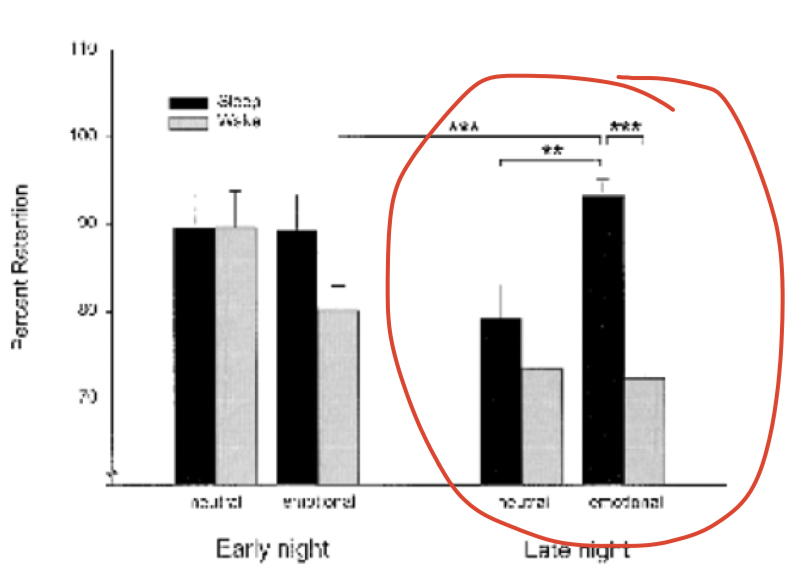
What did Wagner et al. (2001) find?
Researches measured the percent retained for each narrative and found that text retention, especially for emotional content was enhanced following late night sleep
there was only a difference between sleep and wake in the interval when learning occurred later in the night
Suggests that the second half of the night with a greater proportion of REM sleep may play a role in retention of negative emotional memories
Sleep can distinguish between emotional and neutral memories

What did Payne et al. do (sleep and emotional info)?
Asked whether a negative scene can affect consolidation but also whether an attentional bias can translate through memory and consolidation (negative central object reduce encoding of background)
Showed Ps photos with either a negative of neutral central object (intact vs crashed car) with similar background then Ps had to recognise these objects as well as the backgrounds of these images after a varied interval of either 30 mins, 12 hours of wake or 12 hours of sleep
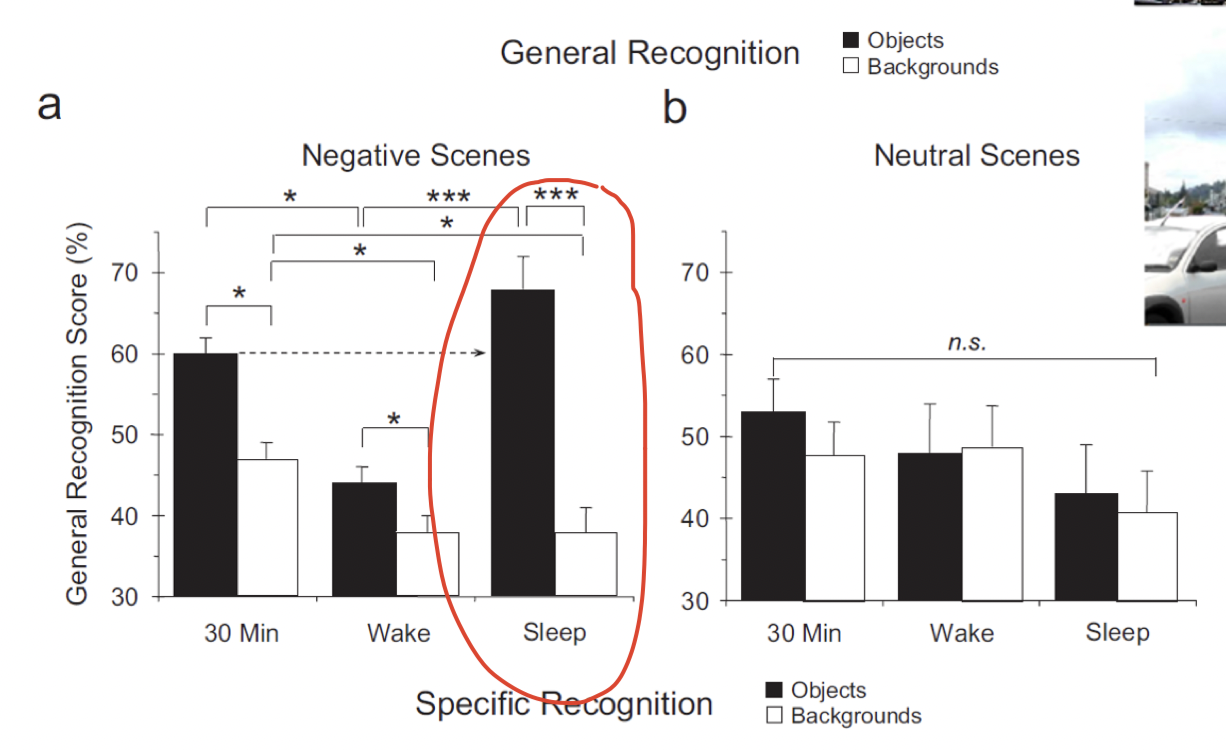
What did Payne et al. find?
Found no significant differences in recall of central and background objects for each interval for neutral scenes
For negative scene, found that sleeping in the interval enhanced memory for the central negative object and reduced memory of the recall of the background (forgetting). While all intervals resulted in enhanced memory of the negative object, this was greatest in the sleep group
Suggests there is a trade-off between emotional objects and background details during encoding and consolidation
If people have experienced a traumatic event sleep may be negative as consolidation should be prevented
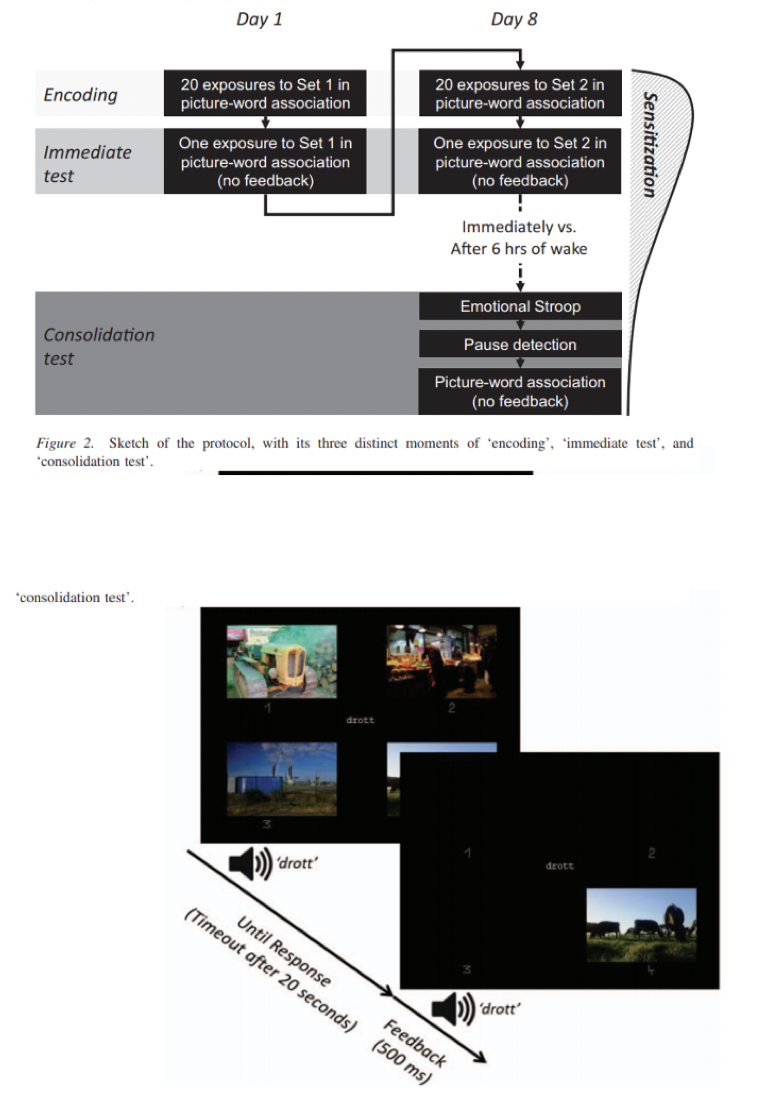
What did Dumay et al. (2018) do?
Wanted to investigate whether any background, non-emotional information that is later associated with threat could become threatening themselves
To do this used nonwords, Ps were presented with these words and heard someone say the nonword and had to learn which of four images that nonword was associated with (half with neutral images and other half with negative emotional images). By repeated exposure, would learn associations and nonwords given emotional content
Overall, Ps were trained with 2 sets of words, the first was trained on day 1, the second on day 8, which is when consolidation testing occurred, looking at the role of time and sleep on emotional associations. The testing phase occurred after learning the second word set either immediately or after 6 hours of wake
What did Dumay et al. (2018) give participants in the testing phase?
An emotional Stroop test, does the emotional valence of the nonwords prevent responses during the task
Pause detection task where Ps have to listen to the nonwords and recognise if there is a disruption in the speech file
For both of these tasks, the emotional aspect is not central to the task rather the learnt associations may affect behaviour as a results of the emotional value the nonwords have been given
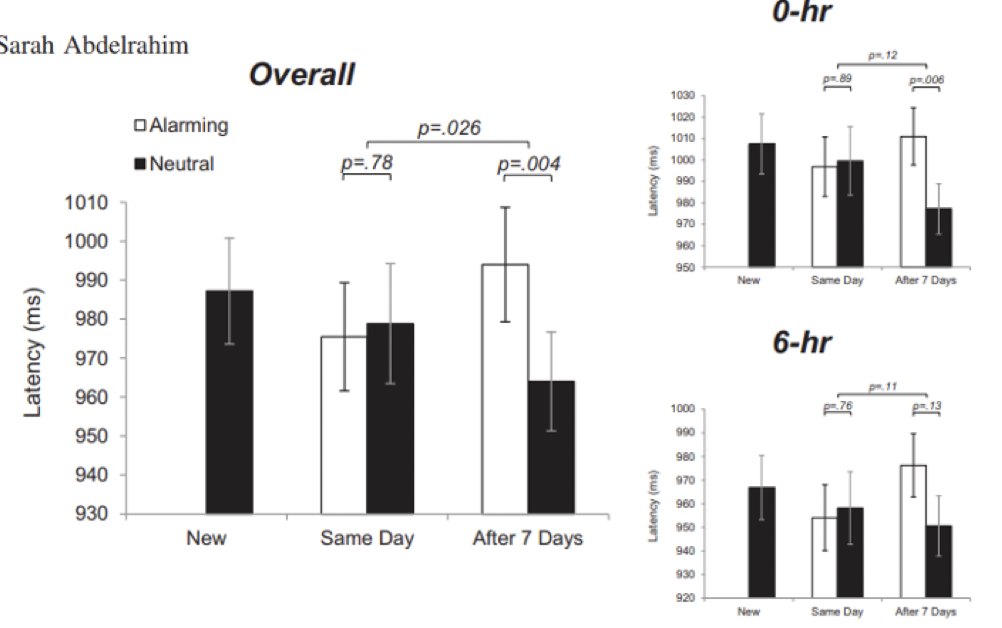
What did Dumay et al. (2018) find?
Found no significant results using the emotional Stroop but did using the pause detection task
Found that words that have been in memory longer seemed to obtain the emotional attributes of their associations, there were longer reaction times for nonwords that had been in memory longer that had negative rather than neutral images
This emotional attribution did not occur for words learnt that day (immediate or 6 hour wake interval) suggesting that sleep consolidation is necessary for emotional associations to be encoded
those in the immediate and 6 hour wake interval testing group showed similar patterns of results indicating that while time is useful, sleep is necessary
Following sleep, neutral stimuli can gain negative emotional associations if presented with other emotional stimuli prior
Summary
Protection against forgetting occurs at the synaptic and systems levels
SWS is characterised by the hippocampus not encoding new information and by neural replay which promotes synaptic and systems consolidation
Synaptic consolidation in the hippocampus may depend on the amount of retroactive interference it may not be specific to sleep
Sleep not only prevents forgetting but also
helps recover information
promotes gist extraction
integrates new information with existing knowledge
Consolidation via sleep enhances declarative memory for alarming elements to the detriment of background details. It also gives originally neutral cues the power to grab attention once they have co-occurred with threat